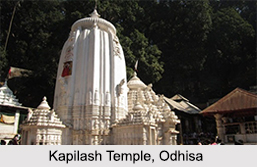 Kailash Temple is situated in the north eastern part of Dhenkanal town in Odisha. It is at a distance of 26 kilometers from the district headquarters. The shrine is placed at an elevation of about 2239 ft from the sea level. The temple is dedicated to Lord Shiva.
Kailash Temple is situated in the north eastern part of Dhenkanal town in Odisha. It is at a distance of 26 kilometers from the district headquarters. The shrine is placed at an elevation of about 2239 ft from the sea level. The temple is dedicated to Lord Shiva.
The temple is richly decorated during the Shivaratri festival. Thousands of devotees visit the temple trekking barefoot to the hilltop to pour water on the Shiva linga.
Architecture of Kapilash Temple
Kapilash Temple was built by Narasinghdeva I of Ganga Dynasty. According to an inscription engraved on the temple he constructed it for Sri Chandrasekhar in 1246 A.D. The chief tower of the temple is 60 feet in height. Kailash temple is located on top of a hill amidst lush green environs. There are two ways to reach the temple. Pilgrims can either climb 1352 steps or travel through the twisting way. The `Payamrta kunda` exists on the left side of the temple and the `Marichi kunda` is on the right side. A wooden Jagamohana i.e. an assembly has been built inside the temple. Kapilash Temple houses the idols of Lord Ganesha, Kartikeya and Gangadevi. Patita pavana Jagannath has been established within the temple as the `Parsa deva`.
Legends of Kapilash Temple
The hills around Kapilash Temple are accompanied by not only several caves but also the ruins of a medieval fort that attracts regular visits of the pilgrims. Few of the caves are also known to be associated with the Pauranic episodes which are a great appeal to the visitors. The great Shridhar Swami, celebrated commentator of the Bhagabat and Mahima Gosain and the founder of the Mahima cult are associated with the Kapilash temple historically. It is believed that the Kapilash Pitha also served as the ashram of sage Kapila. Few scholars hold a view that it is also the second home of Lord Shiva.
Flora and Fauna of Kapilash Temple
The flora and fauna of Kapilash Temple is another addition to the aesthetics of the place. Abundance of segun, sal, mohua, kendu and jarul are found there along with several other plants. The fauna mainly consists of jungle cats, monkeys, squirrels and peacocks. The presence of wild animals and dense forests attract many nature lovers to the site.
Tourism of Kapilash Temple
The Kapilash Temple is well connected by variant transport modes. The nearest railway station is Dhenkanal Railway Station. Regular bus services are also available.





















